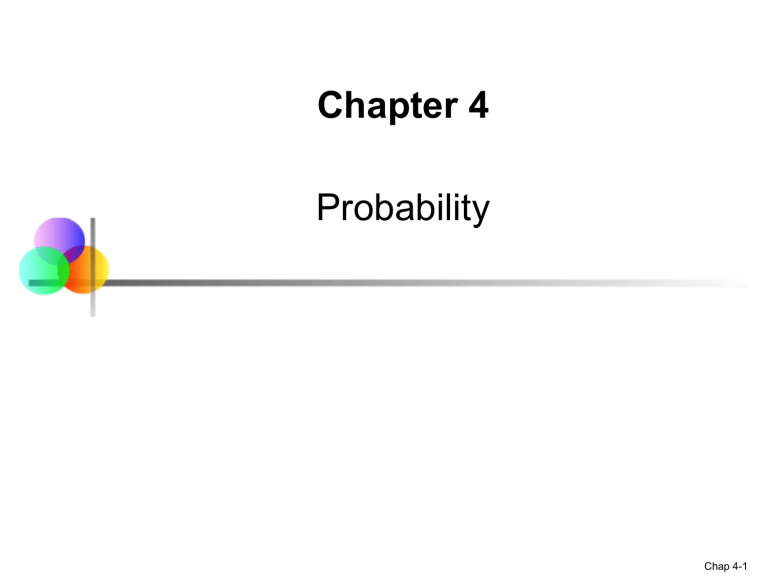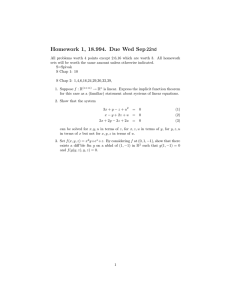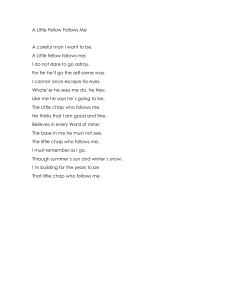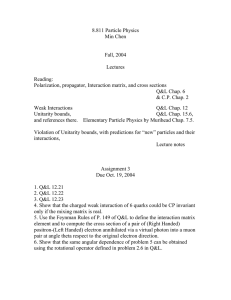
Chapter 4 Probability Chap 4-1 Chapter Goals After completing this chapter, you should be able to: n Explain basic probability concepts and definitions n Use a Venn diagram or tree diagram to illustrate simple probabilities n Apply common rules of probability n Compute conditional probabilities n Determine whether events are statistically independent n Use Bayes’ Theorem for conditional probabilities Chap 4-2 Important Terms n n n n Random Experiment – a process leading to an uncertain outcome Basic Outcome – a possible outcome of a random experiment Sample Space – the collection of all possible outcomes of a random experiment Event – any subset of basic outcomes from the sample space Chap 4-3 Important Terms (continued) n Intersection of Events – If A and B are two events in a sample space S, then the intersection, A ∩ B, is the set of all outcomes in S that belong to both A and B S A AÇ B B Chap 4-4 Important Terms (continued) n A and B are Mutually Exclusive Events if they have no basic outcomes in common n i.e., the set A ∩ B is empty S A B Chap 4-5 Important Terms (continued) n Union of Events – If A and B are two events in a sample space S, then the union, A U B, is the set of all outcomes in S that belong to either A or B S A B The entire shaded area represents AUB Chap 4-6 Important Terms (continued) n Events E1, E2, … Ek are Collectively Exhaustive events if E1 U E2 U . . . U Ek = S n n i.e., the events completely cover the sample space The Complement of an event A is the set of all basic outcomes in the sample space that do not belong to A. The complement is denoted A S A A Chap 4-7 Examples Let the Sample Space be the collection of all possible outcomes of rolling one die: S = [1, 2, 3, 4, 5, 6] Let A be the event “Number rolled is even” Let B be the event “Number rolled is at least 4” Then A = [2, 4, 6] and B = [4, 5, 6] Chap 4-8 Examples (continued) S = [1, 2, 3, 4, 5, 6] A = [2, 4, 6] B = [4, 5, 6] Complements: A = [1, 3, 5] B = [1, 2, 3] Intersections: A Ç B = [4, 6] Unions: A Ç B = [5] A È B = [2, 4, 5, 6] A È A = [1, 2, 3, 4, 5, 6] = S Chap 4-9 Examples (continued) S = [1, 2, 3, 4, 5, 6] n B = [4, 5, 6] Mutually exclusive: n A and B are not mutually exclusive n n A = [2, 4, 6] The outcomes 4 and 6 are common to both Collectively exhaustive: n A and B are not collectively exhaustive n A U B does not contain 1 or 3 Chap 4-10 Probability n Probability – the chance that an uncertain event will occur (always between 0 and 1) 0 ≤ P(A) ≤ 1 For any event A 1 Certain .5 0 Impossible Chap 4-11 Assessing Probability n There are three approaches to assessing the probability of an uncertain event: 1. classical probability probability of event A = n NA number of outcomes that satisfy the event = N total number of outcomes in the sample space Assumes all outcomes in the sample space are equally likely to occur Chap 4-12 Counting sample Points n n Multiplication Rule (with replacement): if an operation can be performed in n1 ways, and if for each of these, a second operation can be performed in n2 ways, the the two operations can be performed in n1n2 ways. Without replacement (ordered): If only k positions are to be filled with objects selected from n different objects, k £ n, the number of possible ordered arrangements is called Permutation. n! P = ( n - k )! k n Chap 4-13 Counting sample Points n Without replacement (unordered): The number of ways in which k objects can be selected without replacement from n objects, when the order of selection is disregarded, is n! C = k !( n - k ) ! k n a combination of the n objects taken k at a time. Chap 4-14 Counting the Possible Outcomes n Use the Combinations formula to determine the number of combinations of n things taken k at a time n! C = k! (n - k)! n k n where n n n! = n(n-1)(n-2)…(1) 0! = 1 by definition Chap 4-15 Assessing Probability Three approaches (continued) 2. relative frequency probability probability of event A = n nA number of events in the population that satisfy event A = n total number of events in the population the limit of the proportion of times that an event A occurs in a large number of trials, n 3. subjective probability an individual opinion or belief about the probability of occurrence Chap 4-16 Probability Postulates 1. If A is any event in the sample space S, then 0 £ P(A) £ 1 2. Let A be an event in S, and let Oi denote the basic outcomes. Then P(A) = å P(Oi ) A (the notation means that the summation is over all the basic outcomes in A) 3. P(S) = 1 Chap 4-17 Probability Rules n The Complement rule: P(A) = 1- P(A) n i.e., P(A) + P(A) = 1 The Addition rule: n The probability of the union of two events is P(A È B) = P(A) + P(B) - P(A Ç B) Chap 4-18 A Probability Table Probabilities and joint probabilities for two events A and B are summarized in this table: B B A P(A Ç B) P(A Ç B ) P(A) A P(A Ç B) P(A Ç B ) P(A) P(B) P( B ) P(S) = 1.0 Chap 4-19 Addition Rule Example Consider a standard deck of 52 cards, with four suits: ♥♣♦♠ Let event A = card is an Ace Let event B = card is from a red suit Chap 4-20 Addition Rule Example (continued) P(Red U Ace) = P(Red) + P(Ace) - P(Red ∩ Ace) = 26/52 + 4/52 - 2/52 = 28/52 Type Color Red Black Total Ace 2 2 4 Non-Ace 24 24 48 Total 26 26 52 Don’t count the two red aces twice! Chap 4-21 Addition Rule Example n A survey of 1000 people determines that 80% like walking and 60% like biking, and all like at least one of the two activities. What is the probability that a randomly chosen person in this survey likes biking but not walking? Chap 4-22 Conditional Probability n A conditional probability is the probability of one event, given that another event has occurred: P(A Ç B) P(A | B) = P(B) The conditional probability of A given that B has occurred P(A Ç B) P(B | A) = P(A) The conditional probability of B given that A has occurred Chap 4-23 Conditional Probability Example n n Of the cars on a used car lot, 70% have air conditioning (AC) and 40% have a CD player (CD). 20% of the cars have both. What is the probability that a car has a CD player, given that it has AC ? i.e., we want to find P(CD | AC) Statistics for Business and Economics, 6e © 2007 Pearson Education, Inc. Chap 4-24 Conditional Probability Example (continued) n Of the cars on a used car lot, 70% have air conditioning (AC) and 40% have a CD player (CD). 20% of the cars have both. CD No CD Total AC .2 .5 .7 No AC .2 .1 .3 Total .4 .6 1.0 P(CD Ç AC) .2 P(CD | AC) = = = .2857 P(AC) .7 Chap 4-25 Conditional Probability Example (continued) n Given AC, we only consider the top row (70% of the cars). Of these, 20% have a CD player. 20% of 70% is 28.57%. CD No CD Total AC .2 .5 .7 No AC .2 .1 .3 Total .4 .6 1.0 P(CD Ç AC) .2 P(CD | AC) = = = .2857 P(AC) .7 Chap 4-26 Multiplication Rule n Multiplication rule for two events A and B: P(A Ç B) = P(A | B) P(B) n also P(A Ç B) = P(B | A) P(A) Chap 4-27 Multiplication Rule Example P(Red ∩ Ace) = P(Red| Ace)P(Ace) æ 2 öæ 4 ö 2 = ç ÷ç ÷ = è 4 øè 52 ø 52 number of cards that are red and ace 2 = = total number of cards 52 Type Color Red Black Total Ace 2 2 4 Non-Ace 24 24 48 Total 26 26 52 Chap 4-28 Statistical Independence n Two events are statistically independent if and only if: P(A Ç B) = P(A) P(B) n n Events A and B are independent when the probability of one event is not affected by the other event If A and B are independent, then P(A | B) = P(A) if P(B)>0 P(B | A) = P(B) if P(A)>0 Chap 4-29 Statistical Independence Example n n Of the cars on a used car lot, 70% have air conditioning (AC) and 40% have a CD player (CD). 20% of the cars have both. CD No CD Total AC .2 .5 .7 No AC .2 .1 .3 Total .4 .6 1.0 Are the events AC and CD statistically independent? Chap 4-30 Statistical Independence Example (continued) CD No CD Total AC .2 .5 .7 No AC .2 .1 .3 Total .4 .6 1.0 P(AC ∩ CD) = 0.2 P(AC) = 0.7 P(CD) = 0.4 P(AC)P(CD) = (0.7)(0.4) = 0.28 P(AC ∩ CD) = 0.2 ≠ P(AC)P(CD) = 0.28 So the two events are not statistically independent Chap 4-31 Statistical Independence Example (continued) n Suppose that a fair six-sided die is tossed. We define the following events: A = “the number of tossed is even” B = “the number of tossed is £ 3” C = “the number of tossed is a 1 or 2” D = “the number of tossed doesn’t start with the letter ‘f’ or ‘t’” a) Find P(B|A), P(B|C) and P(A|C). b) Check the independent of events A and B, B and C, A and C; A and D. Chap 4-32 Bivariate Probabilities Outcomes for bivariate events: B1 B2 ... Bk A1 P(A1ÇB1) P(A1ÇB2) ... P(A1ÇBk) A2 P(A2ÇB1) P(A2ÇB2) ... P(A2ÇBk) . . . . . . . . . . . . . . . Ah P(AhÇB1) P(AhÇB2) ... P(AhÇBk) Chap 4-33 Joint and Marginal Probabilities n The probability of a joint event, A ∩ B: P(A Ç B) = n number of outcomes satisfying A and B total number of elementary outcomes Computing a marginal probability: P(A) = P(A Ç B1 ) + P(A Ç B 2 ) + + P(A Ç Bk ) n Where B1, B2, …, Bk are k mutually exclusive and collectively exhaustive events Chap 4-34 Marginal Probability Example P(Ace) 2 2 4 = P(Ace Ç Red) + P(Ace Ç Black) = + = 52 52 52 Type Color Red Black Total Ace 2 2 4 Non-Ace 24 24 48 Total 26 26 52 Statistics for Business and Economics, 6e © 2007 Pearson Education, Inc. Chap 4-35 Using a Tree Diagram Given AC or no AC: P(A H All Cars A as .7 = ) C C Do e h a v s n ot eA P(A C C)= .3 .2 .7 D C H as P(AC ∩ CD) = .2 D oe s h a ve n o t . 5 CD P(AC ∩ CD) = .5 .7 .2 .3 D C H as D oe s h a ve n o t . 1 CD .3 P(AC ∩ CD) = .2 P(AC ∩ CD) = .1 Chap 4-36 The law of total Probability n Two - event case: P( A) = P( B) P( A | B) + P( B ) P( A | B ) n More than two events P( A) = P( B1 ) P( A | B1 ) + P( B2 ) P( A | B2 ) +…+ P( Bn ) P( A | Bn ) = n å P( B ) P( A | B ) i =1 i i where there are n events in the partition: Bi, i = 1,…, n. Chap 4-37 Example n An analyst believes the stock market has a 0.75 probability of going up in the next year if the economy should do well, and a 0.30 probability of going up if the economy should not do well during the year. The analyst futher believes there is a 0.80 probability that the economy will do well in the coming year. What is the probability that the stock market will go up next year (using the analyst’s assessments)? Chap 4-38 Bayes’ Theorem P(E i | A) = = n P(A | E i )P(E i ) P(A) P(A | E i )P(E i ) P(A | E 1 )P(E 1 ) + P(A | E 2 )P(E 2 ) + + P(A | E k )P(E k ) where: Ei = ith event of k mutually exclusive and collectively exhaustive events A = new event that might impact P(Ei) Chap 4-39 Bayes’ Theorem Example n n n A drilling company has estimated a 40% chance of striking oil for their new well. A detailed test has been scheduled for more information. Historically, 60% of successful wells have had detailed tests, and 20% of unsuccessful wells have had detailed tests. Given that this well has been scheduled for a detailed test, what is the probability that the well will be successful? Chap 4-40 Bayes’ Theorem Example (continued) n Let S = successful well U = unsuccessful well n P(S) = .4 , P(U) = .6 n Define the detailed test event as D n Conditional probabilities: P(D|S) = .6 n (prior probabilities) P(D|U) = .2 Goal is to find P(S|D) Chap 4-41 Bayes’ Theorem Example (continued) Apply Bayes’ Theorem: P(D | S)P(S) P(S | D) = P(D | S)P(S) + P(D | U)P(U) (.6)(.4) = (.6)(.4) + (.2)(.6) .24 = = .667 .24 + .12 So the revised probability of success (from the original estimate of .4), given that this well has been scheduled for a detailed test, is .667 Chap 4-42 Example n A test for a disease correctly diagnoses a diseased person as having the disease with probability 0.85. The test incorrectly diagnoses someone without the disease as having the disease with probability 0.01. If 1% of the people in a population have the disease, what is the chance that a person from this population who tests positive for the disease actually has the disease? Chap 4-43 Chapter Summary n Defined basic probability concepts n n Sample spaces and events, intersection and union of events, mutually exclusive and collectively exhaustive events, complements Examined basic probability rules n Complement rule, addition rule, multiplication rule n Defined conditional, joint, and marginal probabilities n Reviewed odds and the overinvolvement ratio n Defined statistical independence n Discussed Bayes’ theorem Chap 4-44



